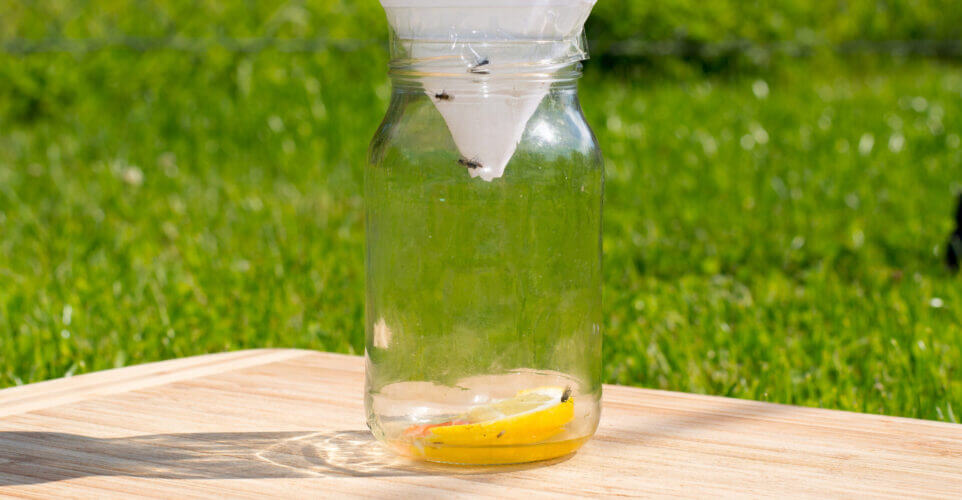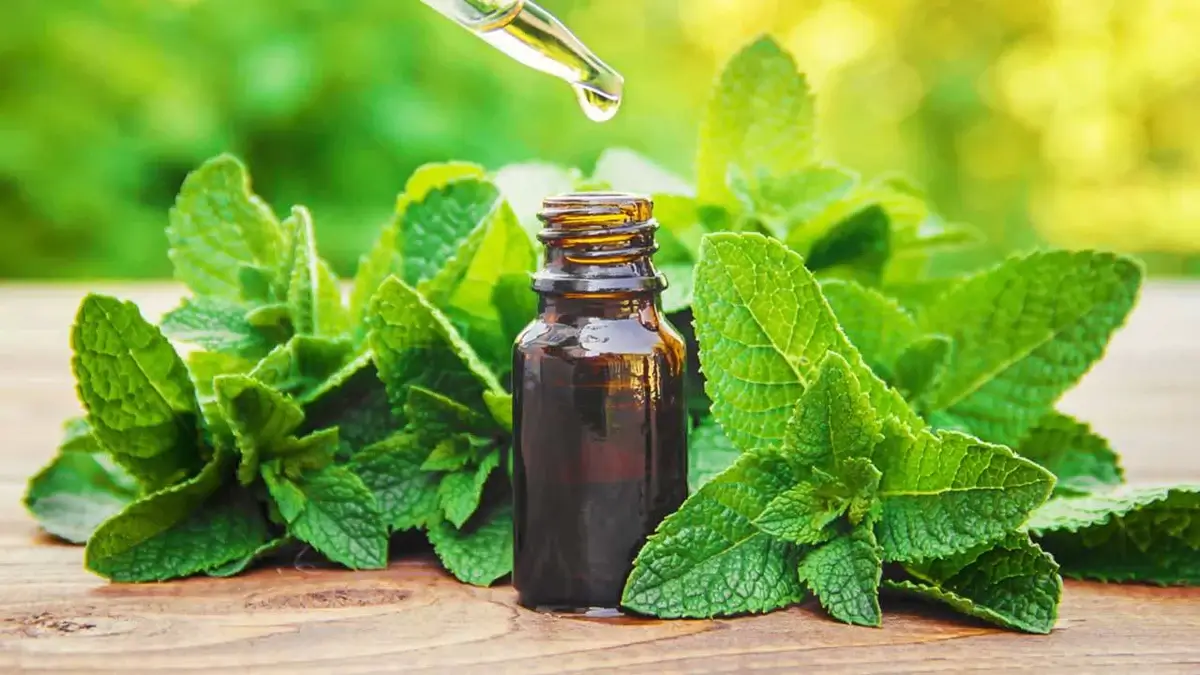 Households can face significant issues due to pests.
Households can face significant issues due to pests.
Even if there’s a single one hovering or flying around at the moment, it is likely that they brought along their friends to a house gathering that you were unaware of hosting.
You could stop things by contacting a professional exterminator. You could attempt to handle it independently using the numerous commercial pest removal sprays available for purchase.
But both choices probably include strong chemicals with unpleasant odors that may pose a threat to your home, especially endangering children and pets.
This is why I always use a natural pest control method or two when it comes to taking care of the pest infestation in my house. Here are a few ideas I usually follow with regards to that.
1: Use a Natural Fly Trap
 Pour sweetened water into an empty soda bottle using sugar, syrup, honey and overripe fruit. But if you want to prevent the bees from invading your house, adding some vinegar drops can help.
Pour sweetened water into an empty soda bottle using sugar, syrup, honey and overripe fruit. But if you want to prevent the bees from invading your house, adding some vinegar drops can help.
The flies will fly into the bottle to taste something sweet. However, as their wings get dampened, it will be impossible for them to fly out again.
Now, if you have fruit flies venturing into your kitchen, you can use apple cider vinegar instead. According to the expert Seattle WA pest control services, all you have to do is to –
- Place a small amount of the liquid in a cup or a bowl
- Seal it with plastic wrap
- Then make small punctures at the top
The tiny insects will enter the openings, but they will not be able to exit once inside. If you keep them there for a while, they might lose their life gradually too.
2: Cloves
Ladybugs usually have a friendly appearance unless… their population becomes too large.
But the good news is – you can easily get rid of them by using a handful of cloves.
The fragrance will give your home a scent of the holidays, but it’s overpowering for them, so they’ll be returned the same way they arrived.
Another fantastic aspect of these natural pest control remedies is that you can experiment with several of them simultaneously if you’re facing various pest issues or have a larger area to treat.
You don’t need to be concerned about any harmful chemicals blending. Actually, your house will probably have a pleasant scent while getting rid of uninvited guests.
3: Dust Mite Oil Repellent
 This technique is effective because mites are unable to tolerate the scents, causing them to avoid the area. To make this repellent, you’ll require Clove oil, Eucalyptus oil, Lavender oil, and either Peppermint or Rosemary oil.
This technique is effective because mites are unable to tolerate the scents, causing them to avoid the area. To make this repellent, you’ll require Clove oil, Eucalyptus oil, Lavender oil, and either Peppermint or Rosemary oil.
Place all items into a water-filled spray bottle to create a dust mite repellent spray. Next, use this spray on the specific spot where dust mites are present. Let the spray air dry.
For those looking to eliminate extra pests, give a blend of basil and lemongrass a go. This approach is highly effective for not only dust mites but also fleas and lice. Using this natural pest control method will help you eliminate dust mites more effectively than ever before.
4: Hot Pepper Spray
This pest management technique is specifically designed for a more heat-tolerant group of pests found in the garden. Attempt blending 1 gallon of water with either 3 tablespoons of hot pepper flakes or 10 finely chopped peppers when using fresh ones.
Cook all the ingredients together in a pan for approximately 15 minutes, then allow it to sit for 24 hours. Following that, you can strain the entire mixture evenly.
You can include a small amount of dish soap to help the solution adhere to your plants. After the mixture is prepared, transfer it into a spray bottle and you’re all set to eliminate the garden pests.
5: Neem Oil
 The neem tree, found in India and other Asian nations, is beneficial for various issues. Neem oil, in essence, is a highly powerful tool, which can help you deter pests at the first sign.
The neem tree, found in India and other Asian nations, is beneficial for various issues. Neem oil, in essence, is a highly powerful tool, which can help you deter pests at the first sign.
Azadirachtin, an active component available in neem branches, inhibits the appetite and affects the growth of the infected insects.
Therefore, it is most effective when dealing with minor pest problems and aiming to control the number of potential pests. Neem oil, also known as a miticide, is considered a strong natural pest control method for eliminating mites. Clarified hydrophobic neem oil sprays can additionally be utilized as fungicides for mildew, leaf spot, scab, and botrytis.
6: Exclusion and Barrier Methods
Barriers and various exclusion techniques establish a boundary that pests are unable or reluctant to cross. For instance, a window screen serves as a barrier to prevent bugs from entering while allowing air to circulate. In contrast, a barrier spray establishes a border that deters insects from a house’s base. Barriers and exclusion techniques work best on pests that follow consistent routes.
Consider rodents and cockroaches that will find always ways to enter homes by squeezing under doorways. An uncomplicated door sweep closes off that gap, preventing pests from entering.
Once you are aware of the pathways pests prefer to use, you can start by blocking them off and then increasing the pressure on them.
If you discover that the roaches originate from an infestation beneath the sidewalk, you can place bait stations strategically to target the roaches closer to their source.
7: Onion and Garlic Spray
 Onions and garlic, commonly found in the kitchen, can eliminate bugs from the garden. The main factor in deterring insects is the distinctive odor of these two ingredients. To make a simple garlic and onion spray, use two to three cloves of each ingredient.
Onions and garlic, commonly found in the kitchen, can eliminate bugs from the garden. The main factor in deterring insects is the distinctive odor of these two ingredients. To make a simple garlic and onion spray, use two to three cloves of each ingredient.
Use a blender to blend these two ingredients together into a puree. Filter the juice with a cloth and then combine it with 100 ml of water. Allow the blend to rest for one night and then apply it generously on your plants. The scent of this repellent will deter the insects.
8: Pepper Spray
Pepper spray, like garlic spray, is a powerful natural deterrent. Pepper spray can be created using fresh chillies or powdered pepper.
Mix two tablespoons of pepper powder with 100-ml of water and 1 tablespoon of liquid soap to make the powder spray. Thoroughly blend and administer by spraying on the impacted regions.
To create the fresh chili spray, blend a small cup of chilies and mix with the water. Warm up this combination until it reaches the temperature at which it starts to boil. Let it sit overnight before mixing it with one tablespoon of liquid soap.
Put the mixture on the impacted areas of the plants. Be careful when combining elements, wear gloves, and avoid touching your eyes.
9: Table Salt
 Table salt is a common natural method for controlling pests, as it disrupts the digestive systems of some insects and eliminates larvae in stagnant water. To effectively combat pests using table salt, mix one part salt with four parts boiling water and apply to areas where pests are present.
Table salt is a common natural method for controlling pests, as it disrupts the digestive systems of some insects and eliminates larvae in stagnant water. To effectively combat pests using table salt, mix one part salt with four parts boiling water and apply to areas where pests are present.
It needs to act fast in order to deter unwanted visitors from entering your premises.
Furthermore, consistently using table salt near areas where insects nest could also be effective in stopping future infestations.
10: Castille Soap
Castile soap is an excellent natural product for repelling unwanted bugs.
The gentle soap solution can have a great effect in repelling some insects and arthropods because of its irritating characteristics. For effective pest control using castile soap, mix 4 tablespoons with 2 quarts of water and pour into a spray bottle.
Spray the blend at entry points, such as doors or windows, and at any potential nesting sites to establish a strong defense against unwelcome visitors.
11: Peppermint Oil
 Peppermint oil is an effective natural remedy for repelling specific bugs such as spiders and ants. The intense odor generates a negative environment that most insects go out of their way to avoid. For pest control using peppermint oil, just combine a couple drops of the essential oil with warm water, then pour it into a spray bottle.
Peppermint oil is an effective natural remedy for repelling specific bugs such as spiders and ants. The intense odor generates a negative environment that most insects go out of their way to avoid. For pest control using peppermint oil, just combine a couple drops of the essential oil with warm water, then pour it into a spray bottle.
Use spray near potential nesting spots to deter unwelcome visitors from settling there.
Moreover, the addition of peppermint oil with ingredients like garlic or basil can enhance the pest-repelling abilities significantly.
12: Almond Shells
Almond shells also serve as a great natural repellent for pests.
Their sharp edges and strong smell can be very effective in deterring undesired creatures like slugs and snails. Just toss almond shells on the paths or walkways in your backyard.
Once the creatures encounter these small shell fragments, they will probably quickly retreat because of the unpleasant sensation on their delicate bodies.
On the other hand, for a stronger option, you could choose to use crushed almond shells instead as they are even more powerful in combatting these insects.
The Bottom Line
Other naturally made repellents are also accessible.
Still, these homemade insect repellent recipes will provide you with a solid foundation to work from. Be vigilant in observing how your plants react to the repellents and adjust your recipes as needed. The goal is not to eliminate all the insects in the garden, since a thriving garden needs beneficial insects, fungi, and microbes. Selecting these excellent, natural deterrents will help you in maintaining your garden without causing harm to the plants and their ecosystem.
Emily Hawthorne
Related posts
Stay connected
Today's pick
- The Importance of Professional Handyman Services for Your HomeYour home is your sanctuary, a place of comfort and security, but maintaining it can be a daunting task. From routine maintenance to unexpected repairs, there’s always something that needs attention. While many homeowners might be tempted to tackle these jobs themselves, not all tasks... The post The Importance of Professional Handyman Services for Your […]
